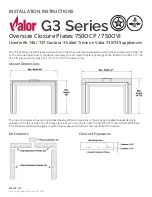
English
INS T ALLAT I ON M A N U A L
2.12 Does appliance switch off
exactly 22 sec after
servomotor starts running?
2.19
Replace gas control
(thermo-electric valve does not
shut down quick enough because
of some permanent magnetism).
2.14 Does main burner go out
after 'some time'?
2.18 Can fire be switched off?
2.20 Perfect!
You have a well functioning
fire
2.16 Is flame picture OK?
2.13
Check cross lighting main
burner and 2nd thermocouple
system.
Measure voltage of 2nd
thermocouple
- Check voltage in mV, 22 sec after
servomotor starts to run, c.q. just
before fire goes out. Glass window
to be mounted!
- Measure between black wire + earth
point on gas control.
-
Requirement:
voltage >5 mV after
rectification actions.
Voltage 0 mV
- 2nd couple defective.
- Cross ligting main burner very slow.
Take actions "Cross lighting too
slow" (see below), before taking any
further action!!
Voltage <1,8 mV
- Cross ligting main burner too slow.
Take actions "Cross lighting too
slow" (see below), before taking any
further action!
- 2nd couple barred. Check:
- 2nd couple free of vermiculite,
chips or pebbles;
- position of logs or pebbles;
- burner holes under 2nd couple
open.
- 2nd couple defective (cross lighting
OK, but voltage creeps up too slow).
- Flames instable, see 2.15. Rectify,
before any other action is taken!!
- Burner pressure (too high or too
low).
- 2nd couple not positioned correctly
in flame.
Bend into correct position (see fig.
43).
- 2nd thermocouple positioned
correctly (see manual). Bend into
flame (only if cross lighting and
flame picture are OK!! See 2.17).
Voltage > 1,8 mV
- Receiver defective. Replace.
Cross lighting of main burner too
slow
Measure the time in sec from start
running of servomotor till the flame
reaches the 2nd couple.
Requirement:
the flame must be in
position at the 2nd couple <10 sec.
If not, check:
- 2nd couple free from vermiculite,
chips or pebbles;
- position of logs or pebbles;
- burner holes (locally) blocked.
Remove vermiculite dust.
- vermiculite missing or not evenly
distributed across burner(s);
- chips on burner;
- lack of combustion air. See 2.15.
- cross lighting in low setting
(possible when thermostat function
is used).
2.15 Check
Gas supply
- Supply pressure does not drop
away as main burner (or other
appliance) lights, causing pilot
flame to shorten.
- Burner pressure (too high or too
low).
Flames instable (suffocating, lack
of air).
Dancing flames on burner.
Lack of combustion air. Check:
- flue system permissible;
- proper flue terminal used, make
should be 'DRU';
- terminal correctly sited on roof or
wall relative to obstructions;
- integrity of flueing system (no
interruptions, not barred,
cobwebs);
- air inlet guides;
- flue restrictor/damper;
- throttle rings.
See manual for specific
requirements.
PowerVent®
Possibly not enough draught. Check
if pressure difference set too high.
Consult PowerVent® installation
manual.
Pilot burner
- Pilot burner dirty. Weak pilot
flame being drawn away by
flames main burner.
Clean with compressed air.
See 2.04.
2.17 Check
Flames: too low
- Supply pressure does not drop
away as main burner or other
appliances in the building light,
causing flames to shorten.
- Burner pressure (too low).
- False air: Check soundness glass
window gasket/ soundness of the
connection of the glass panes of
two/three sided appliances (no
slots allowed).
Flames: too high
- Line pressure.
- Burner pressure.
Flames: no even distribution or
out on part of the burner(s)
- Position of logs or pebbles.
- Burner holes (locally) blocked.
Remove vermiculite dust.
- Vermiculite not distributed evenly
across burner(s).
- Adjustment of throttle ring(s).
Flames: too blue/too yellow or
sooting
- Air inlet guides.
- Flue restrictor/damper.
- Adjustment of throttle ring(s).
Flames: suffocating: lack of air
You see dancing flames on burner,
seeking for air. See 2.15.
Flame picture 'restless'
Indication of too much draught.
Check:
- adjustment of appliance damper
and air inlet guides);
- vertical flue length allowed (<12
m);
- window glass not mounted gas
tight.
PowerVent®? Check:
Possibly too much draught. Check:
- Pressure difference set too high.
- Silicon pressure measurement
hoses leaking.
Consult PowerVent® installation
manual for more info.
no
no
yes
yes
no
yes
yes
no
21
Содержание Global Fires Global 55 CF RCE
Страница 30: ...E n g l i s h INSTALLATION MANUAL 30 38C 2108 0 A X 6 m B X 6 m X R 38C 2106 0 38C 2107 0 16 14 15...
Страница 31: ...E n g l i s h INSTALLATION MANUAL 31 38P 0490 0 A B C 38P 0488 0 38P 0489 0 38p 0023 38P 0028 1 21 17 18 19 20...
Страница 32: ...E n g l i s h INSTALLATION MANUAL 32 38P 0491 0 A 38P 0492 0 B 38P 0493 0 C 22 23 24...
Страница 34: ...E n g l i s h INSTALLATION MANUAL 34 38C 1940 300 150 450 150 150 A B 38c 2111 0 45 44...
Страница 35: ...E n g l i s h INSTALLATION MANUAL 35...
Страница 36: ...E n g l i s h DRU Verwarming B V The Netherlands Postbus 1021 NL 6920 BA Duiven Ratio 8 NL 6921 RW Duiven EN...
















































